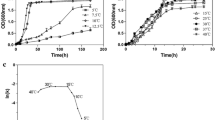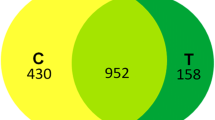Abstract
Proteome analysis of Enterobacter ludwigii PAS1 provide a powerful set of tool to study the cold shock proteins along with that combination of bioinformatics is useful for interpretation of comparative results from many species. There is a considerable interest in the use of psychrotrophic bacteria for nitrogen fixation, especially at hilly regions, thus better understanding of cold adaptation mechanisms too. The psychrotrophic E. ludwigii PAS1 grown at 30 and 4 °C, isolated from Himalaya soil was undertaken for proteomic responses during optimal and cold shock conditions. Comparative proteomic analyses using two-dimensional gel electrophoresis (2-DE) and MALDI-TOF/TOF MS revealed the presence of Cold shock protein E (CspE). Three-dimensional structure of CspE of E. ludwigii PAS1 divulge the presence of five antiparallel β-sheets forming a β-barrel structure with surface exposed aromatic and basic residues that were responsible for nucleic acid binding and also reveals the presence of highly conserved nucleic acid-binding motifs RNP1 and RNP2 in Csp family.





Similar content being viewed by others
References
Altschul SF, Gish W, Miller W, Myers EW, Lipman DJ (1990) Basic local alignment search tool. J Mol Biol 215:403–410
Altschul SF, Madden TL, Schaffer AA, Zhang J, Miller W, Lipman DJ (1997) Gapped BLAST and PSI-BLAST: a new generation of protein database search programs. Nucleic Acids Res 25:3389–3402
Amaro AM, Chamorro D, Seeger M, Arredondo R, Peirano I, Jerez CA (1991) Effect of external pH perturbations on in vivo protein synthesis by the acidophilic bacterium Thiobacillus ferrooxidans. J Bacteriol 173:910–915
Bae W, Phadtare S, Severinov K, Inouye M (1999) Characterization of Escherichia coli cspE, whose product negatively regulates transcription of cspA, the gene for the major cold shock protein. Mol Microbiol 31:1429–1441
Benkert P, Biasini M, Schwede T (2011) Toward the estimation of the absolute quality of individual protein structure models. Bioinformatics 27:343–350
Bordoli L, Kiefeer F, Arnold K, Benkert P, Battey J, Schwede T (2009) Protein structure homology modelling using SWISS-MODEL workspace. Nat protoc 4:1–13
Bradford MM (1976) A rapid and sensitive method for the quantitation of microgram quantities of protein utilizing the principle of protein-dye binding. Anal Biochem 72:248–254
Chan YC, Wiedmann M (2009) Physiology and genetics of Listeria monocytogenes survival and growth at cold temperatures. Crit Rev Food Sci Nutr 49:237–253
Ermolenko DN, Makhatadzea GI (2002) Bacterial cold-shock proteins. Cell Mol Life Sci 59:1902–1913
Feng Y, Huang H, Liao J, Cohen SN (2001) Escherichia coli poly(A)-binding proteins that interact with components of degradosomes or impede RNA decay mediated by polynucleotide phosphorylase and RNase E. J Biol Chem 276:31651–31656
Garnier M, Sebastien M, Didier C, Marie FP, Francoise L, Odile T (2010) Adaptation to cold and proteomic responses of the psychrotrophic biopreservative Lactococcus piscium strain CNCM I-4031. Appl Envtl Microbiol 76:8011–8018
Gualerzi CO, Giuliodori AM, Pon CL (2003) Transcriptional and post-transcriptional control of cold-shock genes. J Mol Biol 331:527–539
Harrington EW, Trun NJ (1997) Unfolding of the bacterial nucleoid both in vivo and in vitro as a result of exposure to camphor. J Bacteriol 179:2435–2439
Horn G, Hofweber W, Krener W, Kalbitzer HR (2007) Structure and function of bacterial cold shock proteins. Cell Mol Life Sci 64:1457–1470
Hu KH, Liu E, Dean K, Gingras M, Graff WD, Trun NJ (1996) Overproduction of three genes leads to camphor resistance and chromosome condensation in Escherichia coli. Genetics 143:1521–1532
Jung YH, Yi Ji-Yeun, Hyun JJ, Yoo KL, Hong KL, Mahendran CN, Ji-hyun U, Seul J, Eun JJ, Hana I (2010) Overexpression of Cold Shock Protein A of Psychromonas arctica KOPRI 22215 confers cold-resistance. Protein J 29:136–142
Mega R, Manzoku M, Shinkai A, Nakagawa N, Kuramitsu S, Masui R (2010) Very rapid induction of a cold shock protein by temperature downshifts in Thermus thermophilus. Biochem Biophy Res Comm 399:336–340
Moon C, Jeong K, Kim HJ, Heo Y, Kim Y (2009) Recombinant expression, isotope labeling and purification of cold shock protein from Colwellia psychrerythraea for NMR study. Bull Korean Chem Soc 30:2647–2650
Novo MT, Junior OG, Ottoboni LM (2003) Protein profile of Acidithiobacillus ferrooxidans exhibiting different levels of tolerance to metal sulfates. Curr Microbiol 47:492–496
O’Farrell PH (1975) High resolution two-dimensional electrophoresis of proteins. J Biol Chem 250:4007–4021
Phadtare S (2004) Recent developments in bacterial Cold-shock response. Curr Issues Mol Biol 6:125–136
Phadtare S, Inouye M (2001) Role of CspC and CspE in regulation of expression of RpoS and UspA, the stress response proteins in Escherichia coli. J Bacteriol 183:1205–1214
Phadtare S, Inouye M, Severinov K (2002) The nucleic acid melting activity of Escherichia coli CspE is critical for transcription antitermination and cold acclimation of cells. J Biol Chem 277:7239–7245
Rodrigues DF, Tiedje JM (2008) Coping with our cold planet. Appl Envtl Microbiol 74:1677–1686
Schmid B, Jochen K, Eveline R, Martin JL, Roger S, Taurai T (2009) Role of cold shock proteins in growth of Listeria monocytogenes under cold and osmotic stress conditions. Appl Environ Microbiol 75:1621–1627
Schwede TJ, Kopp NG, Peitsch MC (2003) SWISS-MODEL: An automated protein homology-modeling server. Nucleic Acids Res 31:3381–3385
Seeger M, Jerez CA (1993) Response of Thiobacillus ferrooxidans to phosphate limitation. FEMS Microbiol Rev 11:37–42
Thompson JD, Gibson TJ, Plewniak F, Jeanmougin F, Higgins DG (1997) The CLUSTAL_X windows interface: flexible strategies for multiple sequences alignment aided by quality analysis tools. Nucl Acids Res 25:4876–4882
Varela P, Jerez CA (1992) Identification and characterization of GroEL and DnaK homologues in Thiobacillus ferrooxidans. FEMS Microbiol Lett 77:149–153
Vera M, Guiliani N, Jerez CA (2003) Proteomic and genomic analysis of the phosphate starvation response of Acidithiobacillus ferrooxidans. Hydrometallurgy 71:125–132
Wouters JA, Sanders JW, Kok J, de Vos WM, Kuipers OP, Abee T (1998) Clustered organization and transcriptional analysis of a family of five csp genes of Lactococcus lactis MG1363. Microbiology 144:2885–2893
Yamanaka K, Mitani T, Ogura T, Niki H, Hiraga S (1994) Cloning, sequencing, and characterization of multicopy suppressors of a mukB mutation in Escherichia coli. Mol Microbiol 13:301–312
Acknowledgments
This work is supported by National Bureau of Agriculturally Important Microorganisms (NBAIM)/Indian Council of Agricultural Research (ICAR) Grant to RG. We also acknowledge Director, CSIR-CIMAP, Lucknow for providing the lab facilities.
Author information
Authors and Affiliations
Corresponding author
Rights and permissions
About this article
Cite this article
Kandasamy, P., Chaturvedi, N., Sisodia, B.S. et al. Expression of CspE by a Psychrotrophic Bacterium Enterobacter ludwigii PAS1, Isolated from Indian Himalayan Soil and In silico Protein Modelling, Prediction of Conserved Residues and Active Sites. Curr Microbiol 66, 507–514 (2013). https://doi.org/10.1007/s00284-013-0304-y
Received:
Accepted:
Published:
Issue Date:
DOI: https://doi.org/10.1007/s00284-013-0304-y




